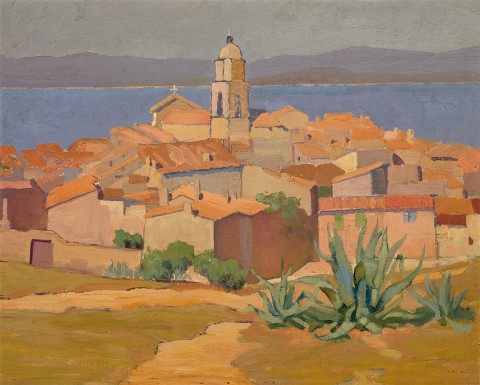ST. TROPEZ, 1924
ELIOTH GRUNER
oil on board
35.0 x 44.5 cm
signed, dated and inscribed lower right: E. GRUNER / FRANCE / 1924
inscribed with title verso: St. Tropez
J. Cannell, New South Wales, c.1928
Thence by descent
Brian Cannell, New South Wales, by 1940
W. D. Gordon, Sydney
Spink Auctions, Sydney, 8 October 1980, lot 144
Private collection, Sydney
Salon National des Beaux Arts, Grand Palais, Paris, 1928
Loan Exhibition of the works of Elioth Gruner, National Art Gallery of New South Wales, Sydney, 21 December 1932 – 21 February 1933, cat. 99
Elioth Gruner Memorial Loan Exhibition, National Art Gallery of New South Wales, Sydney, 17 April – 31 May 1940, cat. 26 (lent by Mr. Brian Cannell)
Elioth Gruner Memorial Loan Exhibition, National Gallery of Victoria, Melbourne, 5 July – 4 August 1940, cat. 38
Elioth Gruner 1882 – 1939, Art Gallery of New South Wales, Sydney, 13 July – 4 September 1983, cat. 45 (label attached verso)
Art in Australia, The Recent Work of Elioth Gruner. Deluxe Edition, Third Series, Ure Smith Publishing, Sydney, no. 27, March 1929, pl. 23 (illus.)
Pearce, B., Elioth Gruner 1882 – 1939, Art Gallery of New South Wales, Sydney, 1983, cat. 45, p. 47
Aloes, St Tropez, c.1924, oil on canvas on board, 37.0 x 35.5 cm, in the collection of the Art Gallery of South Australia, Adelaide
In 1923, Elioth Gruner sailed for London with financial assistance from his friend and patron, the collector Howard Hinton. This was the fulfilment of Gruner’s great desire to see the works of European artists in the flesh. A prodigy of Julian Ashton’s art school, Gruner later ran a small gallery in Bligh Street, Sydney that focussed solely on Australian painting. By the time he left the country, he had also been awarded the Wynne Prize three times and would subsequently win four more. With this in mind, Gruner was asked to manage a large touring exhibition of Australian art to be shown in London – to which he reluctantly agreed. Titled Exhibition of Works of Australian Artists, it was a show dominated by Australian plein air landscape paintings, which sensationally put Gruner at the sharp end of noted British artist Sir William Orpen, who roundly criticised Gruner in front of his paintings – unaware that he was the artist. Realising his mistake, Orpen then – more supportively – gave him a range of suggestions about form, composition and technique. It is to Gruner’s credit that he took these comments seriously. At the exhibition’s end, and possibly in company of Roy de Maistre, he travelled to Paris where, counter-intuitively to his previous studies, he absorbed himself in the work of Cézanne and Gauguin. From Paris, he went to St Tropez and set himself a series of post-impressionist challenges seen in a discrete number of works, of which St Tropez, 1924 is an early example.
One of Cézanne’s most influential statements was that a landscape painting is not real life; it is an image of real life. He flattened planes, stressed the importance of structure, and interrogated the use of paint. Cézanne’s art was the basis for cubism and in many ways, St Tropez recalls George Braque’s famous Houses at l’Estaque, 1908 (Lille Métropole Museum of Modern, Contemporary and Outsider Art), as Gruner crowds his middle ground with the jostle of houses located near the town square, each reduced to a basic planar form. Importantly, his overall small output of work was due to the ‘considerable time (he spent) in the careful pre-consideration of his subject matter and, frequently, a long time in the execution of his picture.’1 In St Tropez Gruner looks toward the Chapelle de la Miséricorde built in 1645 by a quasi-official religious order called the ‘black penitents.’ His subject choice of houses and the domed bell tower is already a marked change as, prior to Europe, urban buildings rarely featured in Gruner’s paintings (one example being The Bustle of Life, 1914, see lot 26) with stray barns and rustic cottages appearing instead. In St Tropez, however, they are the focus, a radical departure for such an artist. Large buildings, when they do appear in his earlier work, are mostly used anonymously as distant zones of delineation; they have no presence other than providing perspective. In reality, the Chapelle’s tower is glazed with green and gold tiles but here, Gruner reduces it to two small sections of soft brown. The distant mountains over the bay are likewise simplified to two solid tones of blue, echoed by a further two roof lines of purpled shadow.
Gruner returned in 1925 and began a fresh take on the Australian landscape. In 1929, his long-time supporter, Art in Australia magazine, published an issue devoted to his work. Reproduced were four of his St Tropez paintings, including this lot, plus one from a boat trip to Capri.2
1. Burdett, B., ‘The Later Work of Elioth Gruner’, Art in Australia, Sydney, 3rd series, no. 27, 1 March 1929, n.p.
2. A fifth St Tropez painting is also known.
ANDREW GAYNOR
